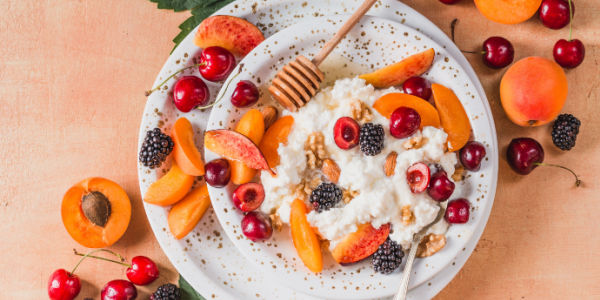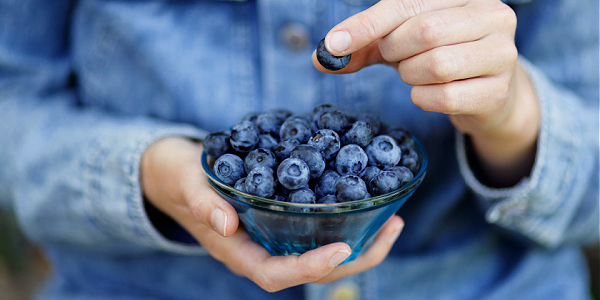
An occasional sweet treat occasionally is absolutely okay, and many people count dessert as one of the small delights in life. However, recent research suggests that over-consuming sugar can engage the pleasure and reward centers of the brain in a way that may mimic addiction.
If you’re wondering how to break your sugar addiction, you’ve come to the right place. This article reveals how to stop sugar cravings and why they happen in the first place. Let’s chew into it!
Understanding Sugar Cravings
There’s no doubt about it: the body needs sugar to survive. Fortunately, the body already has a unique metabolic path to accomplish this.
When you eat carbohydrates (carbs), they are converted into glucose, a simple sugar the body uses for energy. In other words, your body has a pretty smart process to provide a quick fuel source, so you don’t need to supply extra added sugars.
If you have been routinely eating added sugars, it may be hard to differentiate feelings of hunger from sugar cravings, and helpful to think of hunger as the opposite of fullness.
Hunger vs Cravings
Hunger is often less specific than a craving and can be satisfied by a wide range of foods. Cravings, however, are typically for a specific type of food or ingredient (like sugar).
Generally, hunger is physiologically driven, while your eating environment or emotions can influence cravings. Hunger is often considered a need, while cravings are characterized as a desire.
Causes and Risks of Sugar Cravings
Sugar cravings can occur for a few reasons. The leading theory is that fulfilling a sugar craving with excessive sugar intake engages the brain's reward center and produces those “feel-good” hormones we're often so fond of.
Cravings can also be complicated and may occur for a mix of reasons, from having sugary foods easily accessible to eating out of habit. Sugar is relatively easy to digest, so it may stimulate certain appetite hormones, too. The science on sugar suggests that the more you eat it, the more you may feel like you need it.
There is too much of a good thing regarding sugar. Excessive sugar consumption is related to many health risks, including heart disease. Since sugar raises blood sugar quickly and can keep blood sugars elevated over time, it can also put individuals at risk for developing prediabetes and type 2 diabetes. To make matters worse, the body turns excess sugar into fat, meaning that too much sugar in the diet may also contribute to weight gain.
It’s important to note that craving sugar or cravings for sweet foods aren’t “evil” in and of themself. However, always acting on or indulging in these cravings can undoubtedly be linked with problems down the line for long-term health. Letting the cravings take over may ultimately impact your relationship with food and your body.
Is Sugar Addiction Real?
There may be some validity to the concept of a sugar addiction. Eating sugar can cause a release of “feel good” chemicals, like dopamine and serotonin, in the brain.
Feeling pleasure from eating dessert occasionally is nothing to be ashamed of, but consuming excessive amounts of sugar over time may essentially “train” the brain to view sugar as a reward. Overstimulating the regions of the brain associated with feelings of reward or pleasure—often called the “reward center” or “reward pathway”—is believed to result in compulsive behaviors or addiction.
So-called sugar addictions also share a striking similarity to other addictions. While sugar cravings may initially be satisfied with a small amount of sugar, over time, more and more sugar will likely be needed to satisfy the craving. This “habitual desire,” as often called, can leave you continually seeking enough sugar to get your fill.
Stress hormones are also thought to play a role in taking sugar intake from a craving to an addiction-like status. Some people eat sugar to self-soothe during challenging or stressful situations. Sugar is used as a coping mechanism, and there’s debate among the scientific community as to whether or not this practice is “healthy.”
How to Break Sugar Addiction and Cravings
The good news is that just as excessive sugar can “train” your brain to seek this reward, reducing sugar intake can “teach” your brain to rely less on added sugars. Although the initial weaning period may seem complicated, over time, you’ll find genuine satisfaction from eating truly healthy foods, and your brain and body will thank you for taking this healthful step towards better well-being.
Reduce Sugar Slowly
While cutting sugar “cold turkey” can work for some people, most people find it helpful to taper off added sugars slowly. Aim to reduce sugars a little more each day or week, with the ultimate goal of consuming sugar in small amounts. It can be hard to break a habit, so give yourself some grace along the way!
Exercise Caution with Artificial Sweeteners
Artificial sweeteners can be advantageous since they provide a sweet taste without as many calories. Although most are deemed safe in moderation, scientists suspect they aren’t much better than sugar since they may have other health implications (like altering gut health). Plus, their intense sweetness can bolster cravings.
Aim to use these in moderation, too. If you currently rely heavily on artificial sugars, take the same approach as you would with sugar: Reduce your reliance on these substances slowly over time.
Try Natural Sugars
Did you know certain foods contain natural sugars that make them sweet to the taste? In fact, some of these foods, like fruits, are affectionately called “nature’s candy.” While they won’t give you the same sugar-sweetened “hit” a soda will, eating more of these foods during your transition from more sugar to less sugar can be beneficial.
Sugary foods often contain added sugar and are often considered processed foods. On the contrary, natural sugars from whole foods (such as those found in fruits and vegetables) often come along with vitamins and minerals that promote health. In addition, they naturally taste sweet at a fraction of the calories!
Popular sweet-tasting fruits include:
• Apples
• Bananas
• Grapes
• Figs
• Mangoes
While veggies aren’t necessarily considered sweet, some veggies have a sweeter flavor profile than others. These include sweet potatoes, carrots, and winter squashes (like pumpkin), all of which have been used in well-loved desserts thanks to their sweet leanings. Instead of using these vegetables in a sweet treat, try enjoying them with a few tasty seasonings.
Eat Balanced Meals and Snacks
Even though it’s tempting to skip a meal during a busy day, getting at least three meals each day is essential to ensure cravings don’t rule your decision-making. Reduce cravings by ensuring you eat at least three well-rounded meals each day (and snacks as needed).
Still not feeling satisfied after eating? Including protein, fiber, and healthy fats with each meal can help you feel full for longer. These nutrients can also contribute to stabilizing blood sugar, which may go a long way in staving off cravings between meals.
Make Simple Swaps
When cutting added sugars out, your initial inclination may be to overhaul your diet completely. Making small yet effective swaps may be a more sustainable approach and allow you to enjoy healthier versions of the foods you already know and love.
For example, if you usually satisfy your sweet fix with a nightly ice cream bowl, opt for a Greek yogurt bar instead.
Don’t forget that making homemade versions of your favorite sweet foods can allow you to customize sugar content according to your needs. Homemade peanut butter cups, for instance, can be healthier than the store-bought variety and contain protein, fats, and fiber to promote satiation.
Savor Sweets
It’s important to remember that you don’t have to cut all sugars out completely. Intense restriction may lead to an impulse to eat even more. Instead, when you eat a small amount of sugar, truly mindfully savor your bite.
Indulge intentionally, and be thoughtful about your consumption, rather than thinking of sugar as a food that’s eternally “off limits.” This can also reaffirm a healthy relationship with food.
Replace Cravings with Healthier “Rewards”
Fortunately, sugar isn’t the only substance that provides a dopamine boost to the brain. Activities other than eating sugar can engage reward-signaling in the brain.
Favorite feel-good activities include:
• Laughing at a funny video or joke
• Participating in pleasant exercises or hobbies (like dancing or gardening)
• Playing with a pet
• Taking a walk outside
Cravings have a behavioral component; you can intervene before cravings lead to consumption. Choosing a feel-good activity instead of eating sugar can be empowering and provide a sense of accomplishment, especially if that activity is also health-promoting.
How to Stop Sugar Cravings at Night
What if sugar cravings strike at night? If you’re struggling with this, know you aren’t alone. Dessert is typically eaten in the evening time, after all.
Luckily, there are several ways to stop nighttime sugar cravings in their tracks. Some strategies may help you manage your sweet tooth if you crave sweets at night.
Eat a Healthy Snack Before Bed
If dessert is part of your nighttime ritual, try eating a few naturally sweet foods right before bed as an evening snack. Not only will this leave you satiated, but a small amount of something sweet can quell cravings and send you off to bed feeling satisfied.
For inspiration, a berry parfait or a small square of dark chocolate is an excellent option.
Go to Sleep Earlier
To lessen the risk of cravings, try to go to bed no more than 4 hours after eating a balanced dinner. Often, this can be accomplished by heading to bed earlier. For example, if you typically eat dinner around 6:00 p.m., start your nighttime routine around 9:30 p.m. so you can be in bed by 10:00 p.m.
Get Enough Sleep
It may go without saying, but people tend to make poor diet decisions when tired. Prioritizing adequate sleep each night can give your body (and brain) the energy it needs to make more thoughtful eating choices.
Talk to An Expert
No matter the time of day (day or night), if you feel as though cravings are taking over your life, despite your best efforts, it may be time to talk to a diet expert. A registered dietitian can guide you in making thoughtful nutrition changes and advise you on the following steps if binges occur.
Dietitians can also help you rebuild your relationship with food and teach you how to indulge in sweets healthily and without guilt.
How to Stop Sugar Cravings: Lasting Takeaways
Sugar cravings can be troublesome, especially if you are trying to lose weight or reduce your risk of chronic conditions like heart disease or diabetes. Although eating an excessive amount of sugar can develop into an addiction over time, reducing your sugar intake can be a health-promoting practice that helps “train” your body and brain to rely on sweet foods less and less.
Understanding how sugar interacts with the brain’s reward systems can empower you to choose more fruitful activities instead of eating sugar-filled foods, such as exercising.







